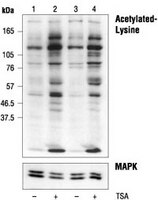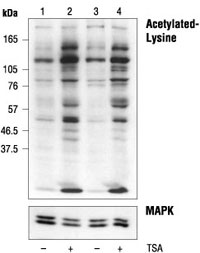ST1027 Sigma-AldrichAnti-Acetylated Lysine Rabbit pAb
Anti-Acetylated Lysine, rabbit polyclonal antibody that recognizes acetylated lysine in UV-treated HEK293 cells. It is validated for ELISA, Western blotting, immunoprecipitation, & paraffin sections.
More>> Anti-Acetylated Lysine, rabbit polyclonal antibody that recognizes acetylated lysine in UV-treated HEK293 cells. It is validated for ELISA, Western blotting, immunoprecipitation, & paraffin sections. Less<<Anti-Acetylated Lysine Rabbit pAb MSDS (material safety data sheet) or SDS, CoA and CoQ, dossiers, brochures and other available documents.
Recommended Products
概述
| Replacement Information |
|---|
重要规格表
| Species Reactivity | Host | Antibody Type |
|---|---|---|
| A Broad Range Of Species | Rb | Polyclonal Antibody |
Products
| 产品目录编号 | 包装 | 数量 / 包装 | |
|---|---|---|---|
| ST1027-50ULCN | 塑胶安瓿;塑胶针药瓶 | 50 ul |
| References | |
|---|---|
| References | Yu, X., et al. 2002. J. Natl. Cancer Inst. 94, 504. Mal, A., et al. 2001. EMBO J. 20, 1739. Sano, Y. and Ishii, S. 2001. J. Biol. Chem. 276, 3674. |
| Product Information | |
|---|---|
| Form | Liquid |
| Formulation | In 150 mM NaCl, 10 mM sodium HEPES, 100 µg/ml BSA, 50% glycerol, pH 7.5. |
| Positive control | HEK293 cells treated with UV |
| Preservative | None |
| Quality Segment | MQ100 |
| Biological Information | |
|---|---|
| Immunogen | synthetic acetylated-lysine |
| Host | Rabbit |
| Isotype | IgG |
| Species Reactivity |
|
| Antibody Type | Polyclonal Antibody |
| Physicochemical Information |
|---|
| Dimensions |
|---|
| Materials Information |
|---|
| Toxicological Information |
|---|
| Safety Information according to GHS |
|---|
| Safety Information |
|---|
| Product Usage Statements |
|---|
| Packaging Information |
|---|
| Transport Information |
|---|
| Supplemental Information |
|---|
| Specifications |
|---|
| Global Trade ITEM Number | |
|---|---|
| 产品目录编号 | GTIN |
| ST1027-50ULCN | 04055977208672 |
Documentation
Anti-Acetylated Lysine Rabbit pAb MSDS
| 职位 |
|---|
Anti-Acetylated Lysine Rabbit pAb 分析证书
| 标题 | 批号 |
|---|---|
| ST1027 |
参考
| 参考信息概述 |
|---|
| Yu, X., et al. 2002. J. Natl. Cancer Inst. 94, 504. Mal, A., et al. 2001. EMBO J. 20, 1739. Sano, Y. and Ishii, S. 2001. J. Biol. Chem. 276, 3674. |
小册子
| 标题 |
|---|
| Antibody Sourcebookル Sixth Edition |








